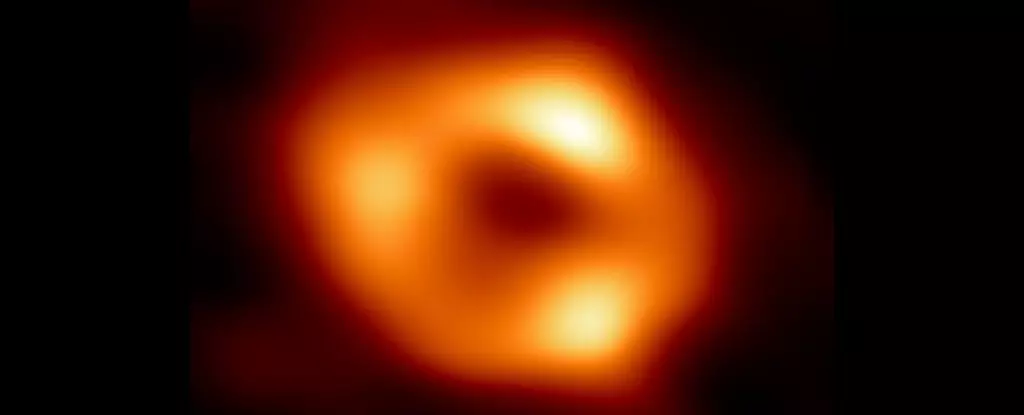The groundbreaking image of Sagittarius A* (Sgr A*), the supermassive black hole at the center of the Milky Way, captured by the Event Horizon Telescope (EHT) team in 2022, represented a monumental achievement in astrophysics. However, recent re-evaluations by researchers at the National Astronomical Observatory of Japan (NAOJ) suggest that our understanding of this cosmic entity may require significant revision. The newly analyzed data implies a more elongated accretion disk than the initially perceived circular structure, sparking fresh dialogues about the methods used in imaging astrophysical phenomena.
To comprehend the implications of this new analysis, we must first appreciate the intricacies involved in capturing images of black holes. The EHT’s original image was produced using a network of eight synchronized ground-based radio telescopes, which generated interferometric data. Such data is notoriously difficult to interpret due to gaps in the information collected—essentially, no single telescope can capture a perfect image of these distant astronomical objects. Each telescope measures electromagnetic emissions from the black hole; however, the combination of these measurements often requires complex algorithms to fill in the missing pieces.
The NAOJ’s approach, as described by astronomer Miyoshi Mikato, highlighted how these gaps can lead to artifacts in the imaging process. The EHT’s methods produced a result that seemed round, but Miyoshi’s team suggests this was perhaps a function of the technique used rather than a true representation of Sgr A*. This contention raises an important question about how much faith we can place in any singular imaging method when it comes to black holes.
The core of the black hole’s image—its accretion disk—plays a critical role in our understanding of Sgr A*. This disk is composed of superheated material that spirals into the gravitational well of the black hole, generating immense temperatures that result in the emission of x-rays, visible light, and radio waves. As this material rotates, it does not do so uniformly; instead, various dynamics including the spin of the black hole, the rate at which material is being consumed, and the angular momentum of the gases affect its shape and brightness.
In light of the NAOJ’s findings, the more elongated structure and the brightness disparity between the eastern and western halves of the disk imply that the material is moving at astonishing speeds—up to 60% of the speed of light in the case of Sgr A*. This revelation not only challenges the initial depiction of the accretion disk but also provides clues regarding the underlying physics at play.
Artifacts of Imaging and Data Interpretation
Investigating why two teams could arrive at different conclusions using the same data is crucial for advancing our understanding of cosmic phenomena. The EHT team’s circular image was fashioned through a carefully constructed process that inadvertently may have muddied the true representation of the accretion disk. In contrast, the NAOJ employed alternative mapping techniques that might have rectified these gaps more effectively, thereby yielding a different outcome.
These contrasting methodologies highlight the necessity for multiple perspectives when studying such complex astronomical objects. Scientists must be cautious about the narratives formed around singular models, recognizing that they can create misrepresentations, both of the object studied and the physics governing them. As both teams continue to refine their techniques, they are paving the way for deeper inquiries into not just Sgr A*, but black holes across the universe.
The Path Forward in Black Hole Research
The ongoing developments around Sgr A* underscore the importance of continuous reevaluation in scientific research. The fact that images of astronomical phenomena are subject to reinterpretation emphasizes the dynamic nature of science itself. Each new analysis contributes yet another layer of understanding to the enigmatic behavior of supermassive black holes and the realms that surround them.
As the EHT consortium works toward further improvements in interferometric imaging techniques, researchers anticipate achieving not just more refined pictures of Sgr A*, but also new insights into the mechanics of black holes and their accretion disks. This evolving narrative around Sgr A* illustrates the richness of astrophysical research and offers a reminder of how curiosity-driven exploration can transform and refine our understanding of the cosmos.
While the beautiful artistry of the initial image of Sgr A* is captivating, the quest for an accurate understanding of such complex entities requires a commitment to continual reassessment and methodological innovation. The revelations from the NAOJ serve as a compelling reminder that what we see is often just the tip of the iceberg in our comprehension of the universe’s mysteries.


Leave a Reply